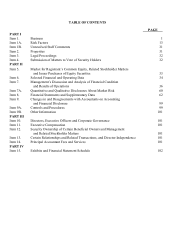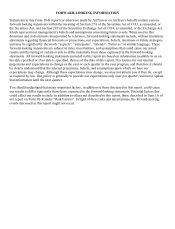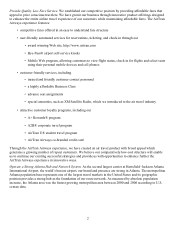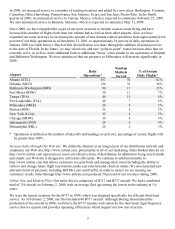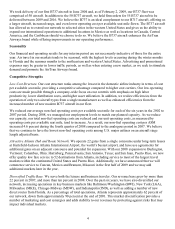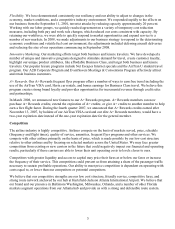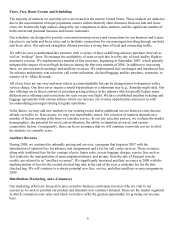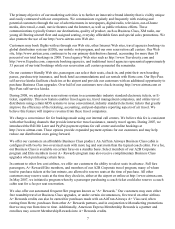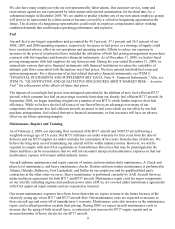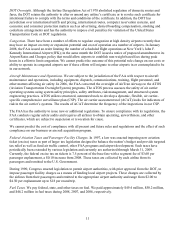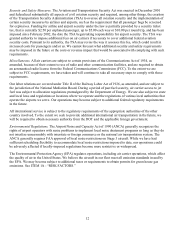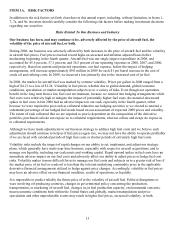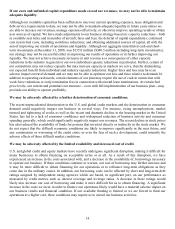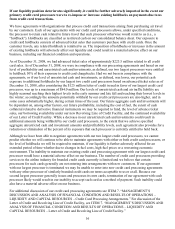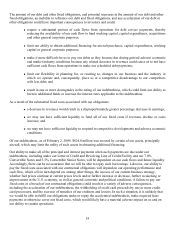Airtran 2008 Annual Report Download - page 16
Download and view the complete annual report
Please find page 16 of the 2008 Airtran annual report below. You can navigate through the pages in the report by either clicking on the pages listed below, or by using the keyword search tool below to find specific information within the annual report.We perform substantially all of our marketing, promotional and media relations in-house and utilize an outside
firm for advertising and public relations.
Computer Reservations
We are a participant in the major travel agency Global Distribution Systems (GDSs), including Amadeus,
SABRE, and Travelport. These systems provide flight schedules and pricing information and allow travel
agents to electronically book a flight reservation without contacting our reservations facility. We pay booking
fees for the completed transactions made in the GDS systems. We also participate with a number of emerging
distribution tools and other internet based booking tools. These companies generally have a lower cost for
participation.
Employees
As of February 2, 2009, we employed approximately 8,000 employees representing approximately 7,600 full-
time equivalents.
Both initial and recurrent training are provided for all employee groups. The average training period for new
employees ranges from approximately one to eight weeks depending on job classification. Both pilot and
mechanic training are provided by in-house training instructors.
Federal Aviation Administration (FAA) regulations require pilots to have commercial licenses with specific
ratings for the aircraft to be flown, and to be medically certified as physically fit to fly. FAA and medical
certifications are subject to periodic renewal requirements including recurrent training and recent flying
experience. In December 2007, federal legislation was enacted increasing the mandatory retirement age for U.S.
commercial airline pilots from age 60 to age 65. Mechanics, quality-control inspectors, and flight dispatchers
must be certificated and qualified for specific aircraft. Flight attendants must have initial and periodic
competency training and qualification. Training programs are subject to approval and monitoring by the FAA.
Management personnel directly involved in the supervision of flight operations, training, maintenance, and
aircraft inspection must also meet experience standards prescribed by FAA regulations. All safety-sensitive
employees are subject to pre-employment, random, and post-accident drug testing.
We have seven craft or classes of employees that are represented by labor unions and are covered by collective
bargaining agreements. The Railway Labor Act governs our relations with these labor organizations. The
agreement with our dispatchers, who are represented by the Transport Workers Union (TWU), was ratified in
October 2004 and became amendable in January 2009. Our agreement with our pilots, who are represented by
the National Pilots Association (NPA), was ratified in August 2001 and became amendable in 2005. During
2007, we reached a tentative agreement with the NPA; however, our pilots declined to ratify the tentative
agreement. Our negotiations with the NPA are currently in mediation under the auspices of the National
Mediation Board.
We have four separate agreements with employee groups represented by the International Brotherhood of
Teamsters (IBT). Our agreement with our maintenance technicians and inspectors was ratified in October 2005
and becomes amendable in October 2009. The agreement with our technical training instructors was ratified in
March 2006 and becomes amendable in March 2011. The agreement with our stock clerks was ratified in June
2006 and becomes amendable in June 2011. Our agreement with our ground service mechanic employees was
effective September 2006 and becomes amendable in September 2011. We have a collective bargaining
agreement with our flight attendants who are represented by the Association of Flight Attendants (AFA). Our
agreement with the flight attendants was ratified in June 2005 and became amendable December 1, 2008.
Negotiations on proposed amendments began in early 2008 and direct negotiations are continuing.
8



